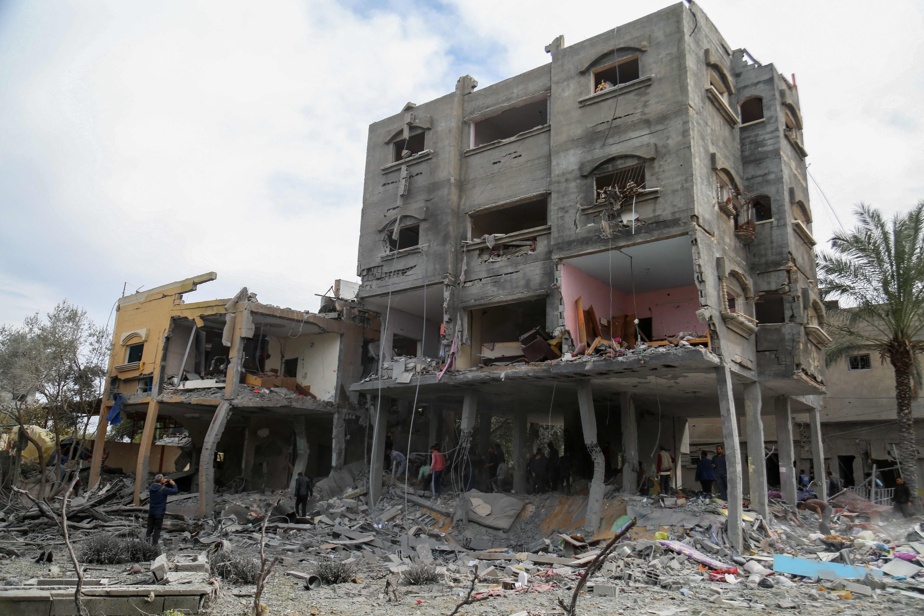Hopes for a truce in the Gaza Strip appear to be revived after Hamas eased its demands, restarting negotiations, as the first aid boat finished unloading its cargo of food into the Palestinian territory on Saturday besieged and threatened by famine.
Read “Butter and Bombs”
Hamas Health Ministry spokesman Ashraf al-Qudra announced early Saturday the deaths of 36 people, including women and children, in a strike on a house crowded with displaced people in Nusseirat ( Center). In total, 123 people have died since Friday evening throughout the territory, according to the same source.

PHOTO AGENCE FRANCE-PRESSE
Palestinians carry a victim pulled from the rubble of a family home hit by Israeli bombardment in the Nusseirat refugee camp on March 16.
The Hamas government reported 60 nighttime strikes on several areas, as well as “violent fighting” in Khan Younes, in the South, and Zaytoun, in Gaza City.
The Palestinian Islamist movement, which has so far demanded a definitive ceasefire from Israel before any agreement on the release of the hostages held in Gaza, said it was ready for a six-week truce, during which 42 hostages — women , children, the elderly and the sick — could be released in exchange for 20 to 50 Palestinian prisoners for each hostage released.
With this in mind, Hamas demands the “withdrawal of the army from all towns and populated areas”, the “return of the displaced without restrictions” and the entry of at least 500 trucks of humanitarian aid per day into Gaza, one of its executives told AFP.
US Secretary of State Antony Blinken, for his part, declared that the mediating countries – which failed to secure a truce agreement as they had hoped before the start of Ramadan on Monday – were working “hard to fill the remaining gap” with a view to a hostage agreement and a truce.
The office of Israeli Prime Minister Benjamin Netanyahu announced that an Israeli delegation would go to Qatar as part of negotiations around this exchange, without specifying when. And the White House said it was “cautiously optimistic” for negotiations on a truce.
In addition to raids and fighting, the UN fears widespread famine in the Palestinian territory, particularly in the north, ravaged by war and difficult to access.
“No more normal-sized babies”
Departing from Cyprus on Tuesday, a boat from the Spanish NGO Open Arms carrying 200 tonnes of food from the organization World Kitchen Central (WCK) arrived on the coast of Gaza on Friday where it finished unloading its cargo on Saturday.
“All the cargo has been unloaded and is being prepared for distribution to Gaza,” WCK said on Saturday, which said it was preparing a second aid ship to Cyprus, with “hundreds of tons of food.” .

PHOTO PROVIDED BY THE ISRAELI ARMY VIA ASSOCIATED PRESS
The barge towed by the boat of the Spanish NGO, Open Arms, was transporting 200 tonnes of food.
Aid transported by land enters the south of the Gaza Strip after having been inspected by Israel, but remains very insufficient compared to the needs of the 2.4 million inhabitants.
International efforts are increasing to try to deliver more humanitarian aid, directly to northern Gaza, by airdrops or via a new maritime corridor from Cyprus.
” I want [de l’aide] for my children. I want them to live and not starve. They only eat wild plants, there is no bread. There is nothing to eat in Gaza. It’s the month of Ramadan and there is nothing,” Abou Issa Ibrahim Filfil, a Palestinian waiting for help, told AFP.
The UN, the European Union, the United States and other countries have reiterated in recent days that the delivery of aid by air or sea cannot replace land routes.
The Open Arms ship had previously been subjected to “a complete security check”, according to the Israeli army which is imposing a complete siege on the territory.

PHOTO YIANNIS KOURTOGLOU, REUTERS
A police officer uses a sniffer dog to inspect the cargo ship loaded with humanitarian aid destined for Gaza on March 16 at the port of Larnaca, Cyprus.
The situation is so dramatic that “doctors no longer see babies of normal size” in Gaza, protested Friday Dominic Allen, head of the United Nations Population Fund (UNFPA) for the Palestinian territories.
They “see more stillborn babies,” lamented Mr. Allen, who was able to go to Gaza, describing pregnant women “exhausted by fear, by the fact of having been displaced several times, by hunger” and the dehydration.
Operation on Rafah?
The war was sparked on October 7 by an unprecedented attack carried out by Hamas commandos infiltrated from Gaza in southern Israel, which resulted in the deaths of at least 1,160 people, most of them civilians, according to a count of AFP from official Israeli sources.
According to Israel, around 250 people have been kidnapped and 130 of them are still hostages in Gaza, of whom 32 are believed to have died.
In retaliation, Israel promised to “annihilate” Hamas and launched an offensive that left 31,490 dead in the Gaza Strip, mostly civilians, according to the Hamas Ministry of Health.
While negotiations are active behind the scenes for a truce, Prime Minister Netanyahu approved the army’s “action plans” for an offensive in Rafah, where, according to the UN, approximately 1 .5 million Palestinians. This operation could take place in the absence of a truce agreement or after a possible six-week pause in the fighting.
“The Israeli army is ready for the operational side and for the evacuation of the population”, according to its services which give no further details on this long-announced operation, against which the United States and the UN continue to oppose to warn.
